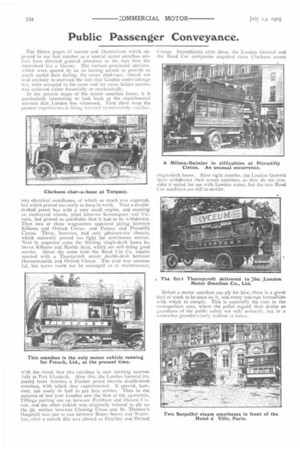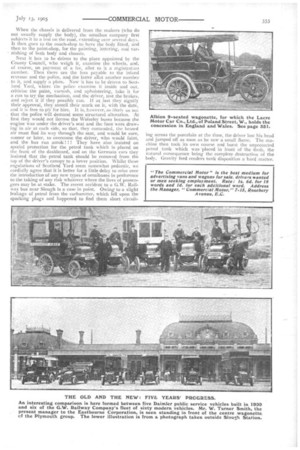Public Passenger Conveyance.
Page 8

Page 9

If you've noticed an error in this article please click here to report it so we can fix it.
The fifteen pages of matter and illustrations which appeared in our laSt number as a special motor omnibus section have directed general attention to the fact that the movement has a history. The various provincial services, which were quoted by us as having served to provide so much useful data during the years I89S-Inot, should not lead anybody to overlook the fact that London undertakings ton, were occupied to the same end for years before success was achieved either financially or mechanicalb,•,
In the present stage of the motor omnibus boom, it is particularly interesting to look back at the experimental services that London has witnessed. First there were the pioneer experiments to bring 1-orward commercially :,.:itisfac tory electrical omnibuses, of which so much was expected, but which proved Lou costly to keep in work. Next a doubledecked petrol bus with a very small engine, and running on steel-tyred wheels, plied between Kennington and Victoria, but proved so unreliable that it had to be withdrawn. Then two Of three wagonettes appeared plying between Kilburn and Oxford Circus, and Putney and Piccadilly Circus. These,. 'however, had v pleasure-car chassis, which -naturally proved too light for continuous service. Next in sequence came the Stirling single-deck buses betwt en Kilburn and Marble Arch, which are still doing good service. About the same time the Road Car Co. experi. located with a Thornycroft steam double-deck between Hammersmith and Oxford Circus. The trial was successful, but terms could not be arranged as to maintenance,
with the result that this omnibus is now running successfully at Port Elizabeth. After this, the London General imported from America a Fischer petrol electric double-deck omnibus, with which they experimented. It proved, however, too cosily in fuel to put into service. Then in the autumn of last year London saw the first of the 1-1-seaters, Tillings putting one on between Peckham and Oxford Circus, and the other (which was originally lettered to ply on the id. service between Charing Cross and St. Thomas's Hospital) was put to run between Baker Street and 'A'aterlco; after a month this was altered to Finchlev and Oxford Circus. Immediately after these, the London General and the Road Car companies acquired three Clarkson steam
singlc-deck buses. After eight months, the London General have withdrawn their steam omnibus, as they do not consider it suited for use with London water, but the two Road Car machines are still in service.
Before a motor omnibus can ply for hire, there is a great deal of work to be done on it, and many red-tape formalities with which to comply. This is especially the case in the metropolitan area, where the police regard their duties as guardians of the public safety not only seriously, but in a somewhat g-randn-lolher!y fashion at times. When the chassis is delivered from the makers (who do not usually supply the body), the omnibus company first subjects it to a test on the road, extendin,, over several day,. It then goes to the coach-shop to have the body fitted, and then to the paint-shop, for the painting, lettering, and varnishing of both body and chassis.
Next it has to be driven to the place appointed by the County Council, who weigh it, examine the wheels, and, of course, on payment of a fee, allot to it a registration number. Then there are the fees payable to the inland revenue and the police, and the latter allot another number to it, and supply a plate. Now it has to be driven to Scotland Yard, where the police examine it inside and out, criticise the paint, varnish, and upholstering, take it for a run to try the mechanism, and the driver, test the brakes, and reject it if • they possibly can. If at last they signify their approval, they stencil their mark on it, with the date, and it is free to ply for hire. It is, however, as ;ikelv as riot that the police will demand some structural alteration. At first they would not license the Wolseley buses because the engine was under the driver's seat and the fans were drawing in air at each side, so that, they contended, the heated air must find its way through the seat, and would be sure, sooner or later, to overcome the driver, who would faint, and the bus run amok! I! They have also insisted on special protection for the petrol tank which is placed on the front of the dashboard, and on the Germain cars they insisted that the petrol tank should be removed from the top of the driver's canopy to a lower position. Whilst these regulations of Scotland Yard seem somewhat pedantic, we cordially agree that it is better for a little delay to arise over the introduction of any new types of omnibuses in preference to the taking of any risk whatever where the lives of passengers may be at stake. The recent accident to a G.W. Railway bus near Slough is a case in point. Owing to a slight leakage of petrol from the carburetter, which Pell upon the sparking plugs and happened to find them short circuit
ing across the porcelain at the time, the driver lost his head and jumped off as soon as he saw a small flame. The machine then took its own course and burst the unprotected petrol tank which was .placed in front of -the dash, the natural consequence being the complete destruction of the hoely. Gravity feed renders tank disposition a hard matter.


















